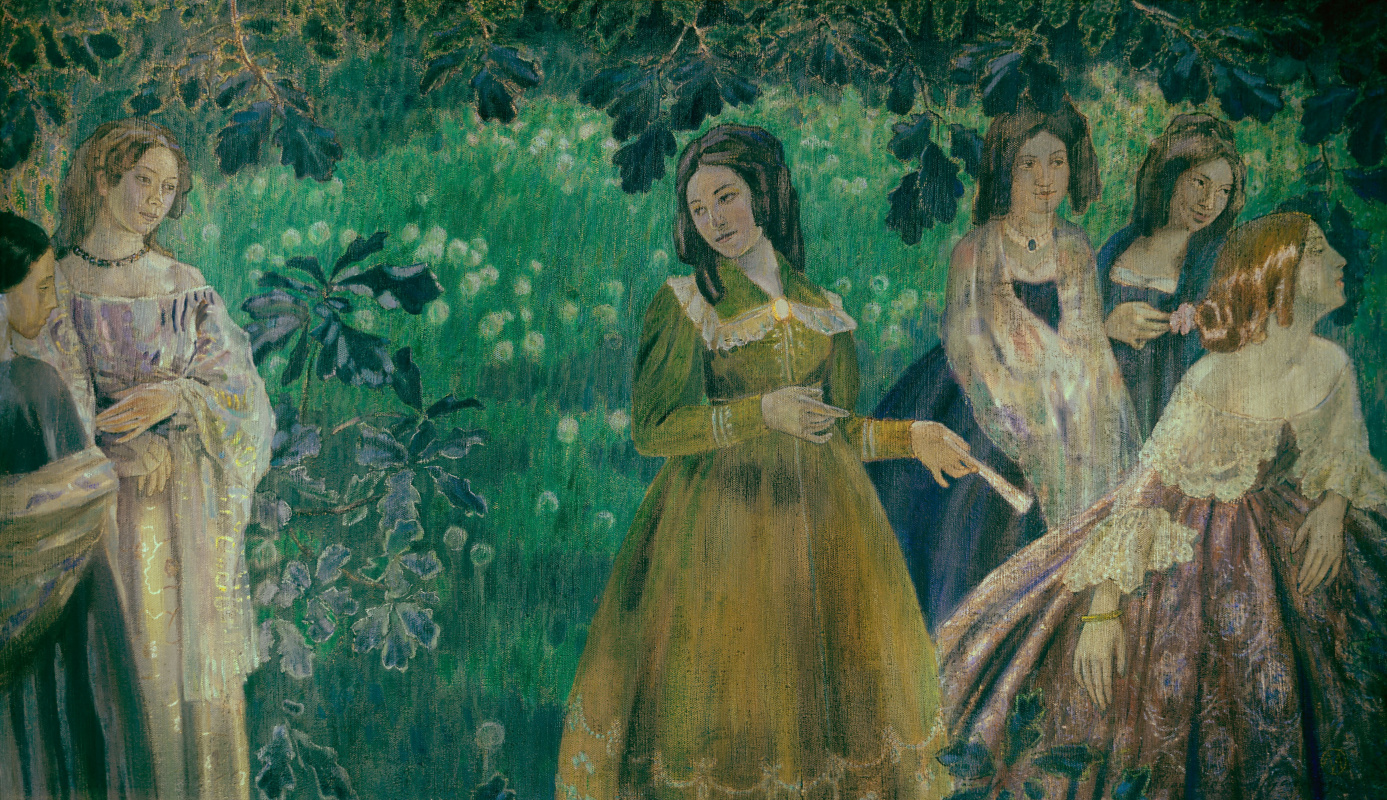log in
Enter site
Login to use Arthive functionality to the maximum
Emerald Necklace
Victor Elpidiforovich Borisov-Musatov • Painting, 1904, 125×214.3 cm
Description of the artwork «Emerald Necklace»
"Emerald Necklace" - this is the second, successful attempt by Borisov-Musatov to enter into dialogue with Puvis de Chavannes... The artist got acquainted with the work of the French Symbolist in Paris. In his opinion, Puvis de Chavannes was the greatest painter of our time. Back in 1897, Borisov-Musatov had an idea for the painting "Motherhood", which was supposed to follow compositional and stylistic principles of Puvis de Chavannes... This picture was never painted, but excellent sketches for it are known. The influence of Gauguin is also clearly noticeable in them: "Agave", "Girl with agave" (the artist's sister Elena posed).
In the Emerald Necklace, Borisov-Musatov refuses the oval composition so much loved by him and the principle of enclosed space. The composition is open in both directions, the extreme characters are cut off with a canvas (a technique revered by the Impressionists). A necklace is not an ornament on one of the girls, it is the “necklace” of the girls themselves, whose dresses sparkle like emeralds. The allegorical necklace that personifies the Eternal Femininity is what Borisov-Musatov shows us. In the palette of this picture, perhaps, the color preferences of Borisov-Musatov are most clearly manifested: blue-green colors play a leading role. Girls are dressed in vintage dresses. The artist explained his passion for past-age clothing as follows: "Women in crinolines are less sensual, more feminine and more like bushes and trees".
Interesting character dynamics. The girl on the left, whose figure is cut off, looks quite sad. Next to her is a thoughtful tall figure. Gradually, with the movement of the gaze to the right, the emotional mood is changing, liveliness is growing: from sadness to calm, easy smile and in the end - the enthusiastic aspiration of the extreme right of the girl. Something interesting is clearly happening behind the right side of the canvas, and it is drawn with interest to this something. Two girls nearby, too, are smiling favorably on that side. The artist does not disclose the riddle, leaving the viewer the opportunity to invent an exciting mystery. The central figure balances and unites the right and left sides of the canvas. It seems to belong to both groups, and at the same time does not belong to any one, but is transitional. By the way, a similar reception with a completely different mood will be used in watercolor "Requiem"dedicated to the artist's deceased friend Nadezhda Stanyukevich.
Author: Alain Esaulova
In the Emerald Necklace, Borisov-Musatov refuses the oval composition so much loved by him and the principle of enclosed space. The composition is open in both directions, the extreme characters are cut off with a canvas (a technique revered by the Impressionists). A necklace is not an ornament on one of the girls, it is the “necklace” of the girls themselves, whose dresses sparkle like emeralds. The allegorical necklace that personifies the Eternal Femininity is what Borisov-Musatov shows us. In the palette of this picture, perhaps, the color preferences of Borisov-Musatov are most clearly manifested: blue-green colors play a leading role. Girls are dressed in vintage dresses. The artist explained his passion for past-age clothing as follows: "Women in crinolines are less sensual, more feminine and more like bushes and trees".
Interesting character dynamics. The girl on the left, whose figure is cut off, looks quite sad. Next to her is a thoughtful tall figure. Gradually, with the movement of the gaze to the right, the emotional mood is changing, liveliness is growing: from sadness to calm, easy smile and in the end - the enthusiastic aspiration of the extreme right of the girl. Something interesting is clearly happening behind the right side of the canvas, and it is drawn with interest to this something. Two girls nearby, too, are smiling favorably on that side. The artist does not disclose the riddle, leaving the viewer the opportunity to invent an exciting mystery. The central figure balances and unites the right and left sides of the canvas. It seems to belong to both groups, and at the same time does not belong to any one, but is transitional. By the way, a similar reception with a completely different mood will be used in watercolor "Requiem"dedicated to the artist's deceased friend Nadezhda Stanyukevich.
Author: Alain Esaulova




